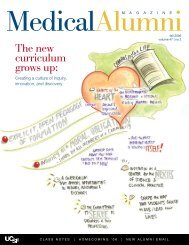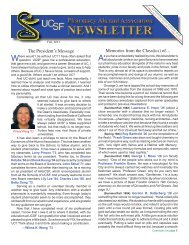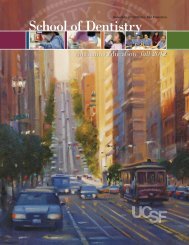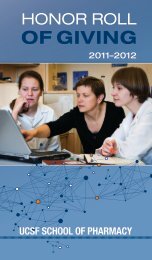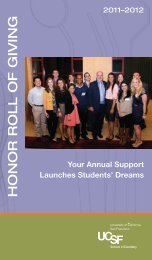here - UCSF Alumni
here - UCSF Alumni
here - UCSF Alumni
You also want an ePaper? Increase the reach of your titles
YUMPU automatically turns print PDFs into web optimized ePapers that Google loves.
educationEngrossing AnatomyBy Anne KavanaghAlmost 60 years ago, Selvyn Bleiferheld a human heart in his handsand knew he was going topursue cardiology. “I remember itvividly,” he says.Bleifer was a first-year medicalstudent at <strong>UCSF</strong> in a course many citeas a rite of passage: gross anatomy.The Class of 1955 graduate can stillsharply recall his initial foray into theanatomy lab – bodies stretched out onmetal tables, the wafting odor ofpreservatives, a classmate quicklyfainting. And later, that beautiful heart.“You can look at a picture of one,”he says, “but it’s different having it inyour hands.”At the time, gross anatomy hadchanged little since the school’sinception in the late 1800s, and wouldchange little for the next half-century.But in 2001 advances in medicineand education would bring sweepingalterations to the teaching of anatomyat <strong>UCSF</strong>.An ancient disciplineAnatomy has perhaps the longesthistory as a discipline in medicaleducation. Yet Hippocrates neverdissected a human body. Neitherdid the esteemed Greek physicianClaudius Galen (A.D. 131-200), whoseinfluential but often erroneous writingson anatomy came from dissectingcats and pigs. Human dissection wasforbidden in most societies until 1240when a Roman emperor permittedit in order to better train doctorsand aid public health. By the early14th century, human dissections –mostly of executed criminals – werebeing conducted at leading Europeanuniversities.In 1865, the California Legislatureapproved a dissection law permittingpauper bodies to be studied byaccredited physicians. At TolandMedical College, the precursor tothe <strong>UCSF</strong> School of Medicine,highlights included “many opportunitiesfor performing autopsies inSan Francisco’s advantageousdissecting climate.” Early on grossanatomy assumed importance,evolving into a 400-hour, six-monthcourse. Four students shared onecadaver. Over time, new medical fieldsand findings transformed othercourses, but gross anatomy heldfirmly to its roots.Doing away with dissectionsThen in 2001 the School of Medicineintroduced a completely redesignedcurriculum. It promoted integration ofdisciplines, an early introduction ofclinical concepts, and expedited entryinto patient care. Eight “block”courses organized around centralthemes or systems constituted the first18 months. Gross anatomy wasintegrated into the introductoryprologue block and instruction wasreduced from about 250 hours to 60.To save time, the school decidedto use previously dissected cadavers,or prosections. Twelve students wouldgather around a body and a facultymember, who would lecture for twohours while pointing things out. “Itturned into a one-way informationhighway,” says Kimberly Topp, PT,PhD, a longtime <strong>UCSF</strong> anatomyprofessor who is now chair of theDepartment of Physical Therapy andRehabilitation Science. “The students’eyes would glaze over.”A second problem: fitting in allpertinent body parts and functions.“The first year, t<strong>here</strong> wasn’t enoughtime for the head and neck,” saysTopp. “Then the head and neck wasadded, but t<strong>here</strong> wasn’t time for upperand lower limbs. So only upper limbswere covered.”Something else was lost, too,something elemental and profound.“You need the hands-on experience ofworking with a human body,” saysAllan Basbaum, PhD, chair of theDepartment of Anatomy. “It signifies:Welcome to the real world. You aredealing with someone who has died.”Laying on of the hands, againAfter two years of prosections,Basbaum charged Topp withrevamping the anatomy curriculum.She focused on making the learningmore interactive, peer-driven andintegrated. As such, dissectionsbecame paramount once again. “Thecadaver is really the students’ firstpatient, and they need to learn asmuch as they can from it,” she says.Today 110 hours are devoted toanatomy. Students spend eight weeksin the prologue block dissectingaspects of the entire body as anintroduction – the “10,000-foot view”as one student describes it.2 | fall 2009




